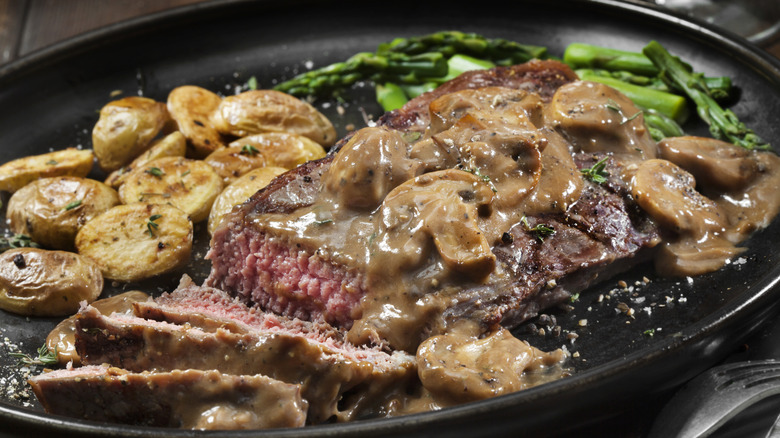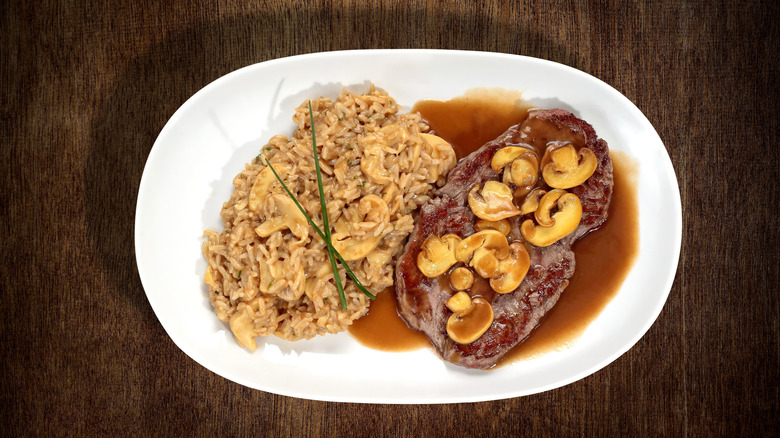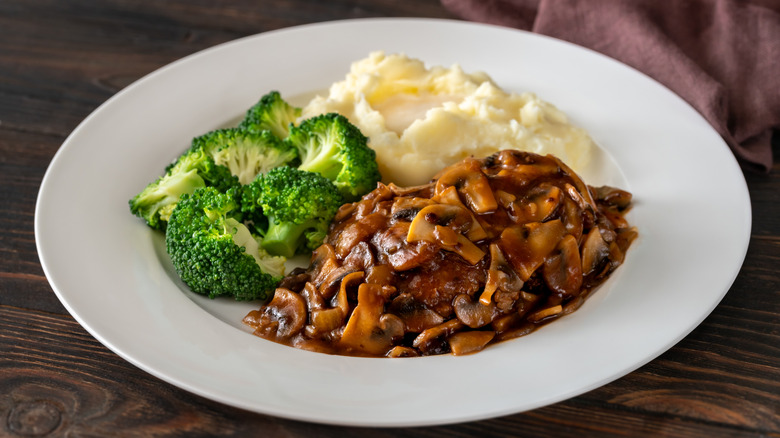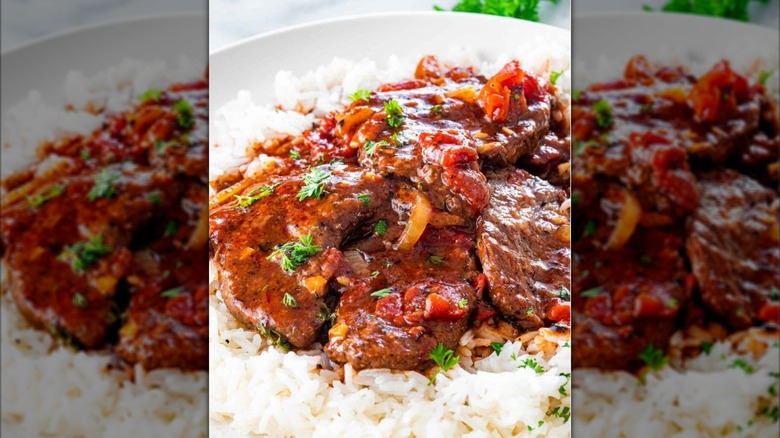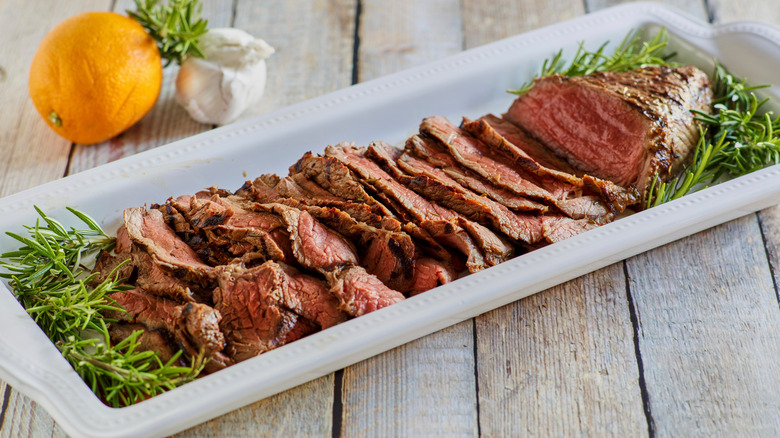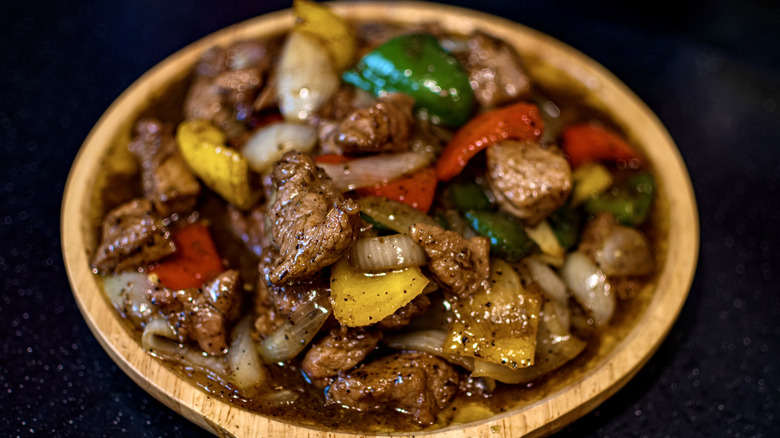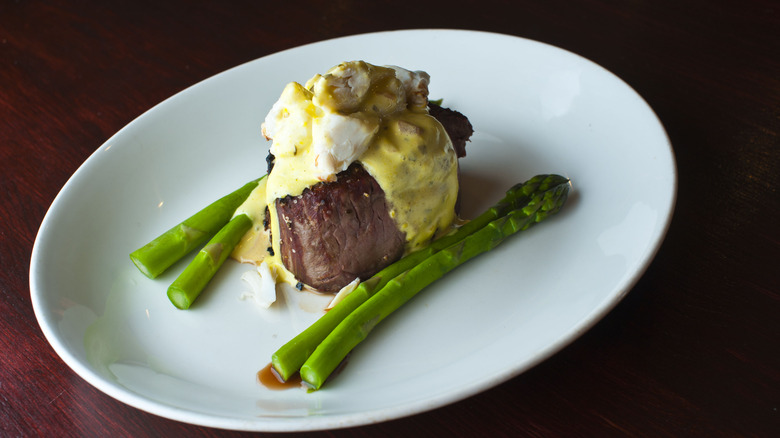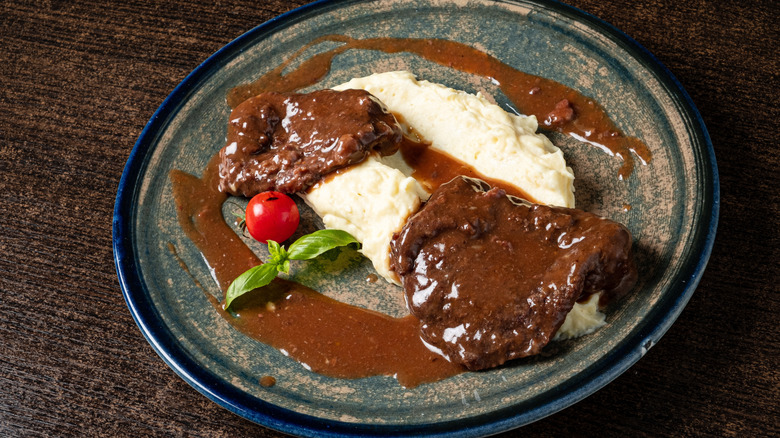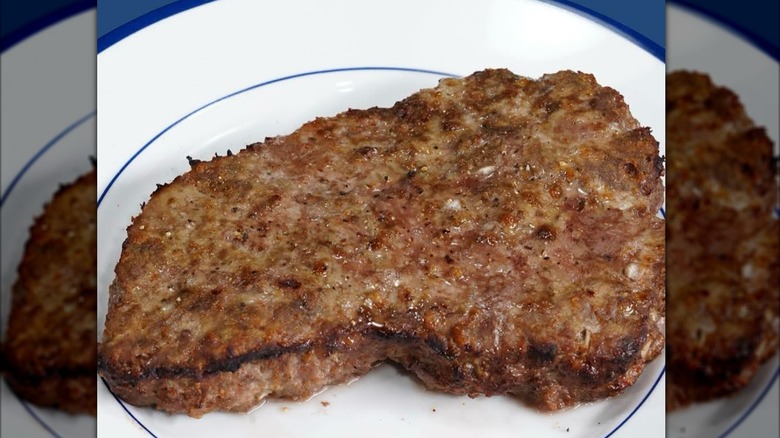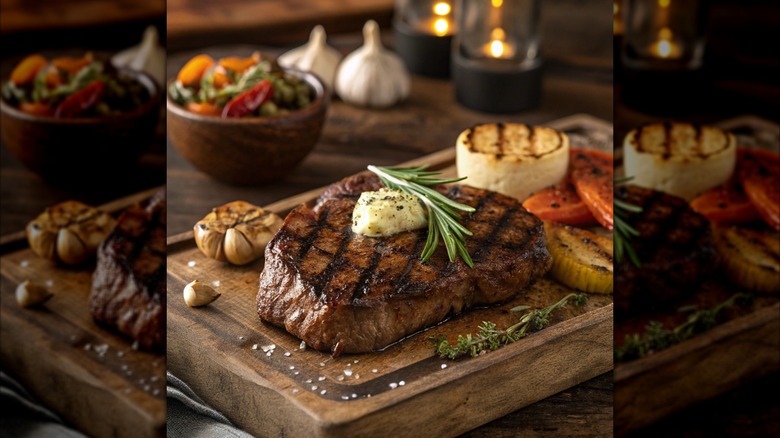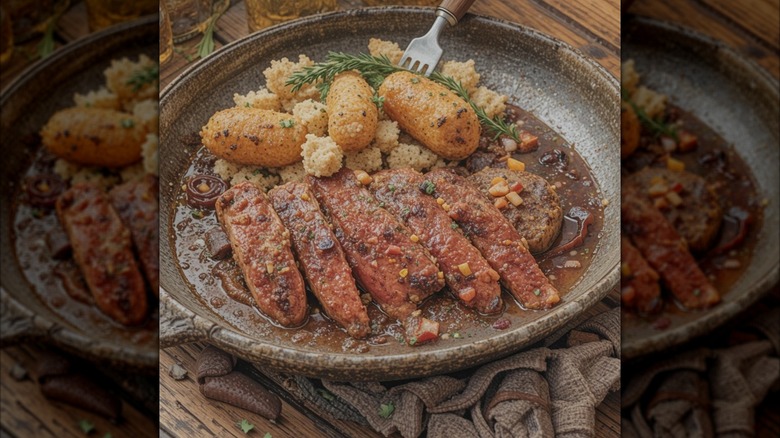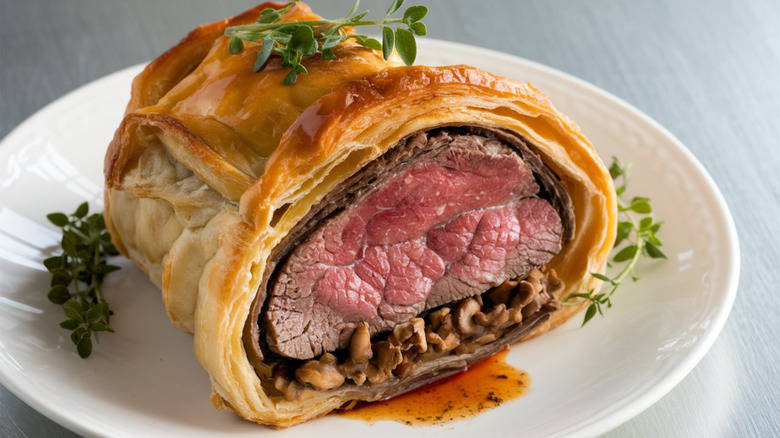Vintage Steak Dishes You Rarely See On Restaurant Menus Today
Steak is a beloved protein for its rich flavor, juicy texture, and unmatched versatility. From lean cuts like flank steak or top round to marbled alternatives like rib-eye or strip steak, there is a steak to suit almost any preference or palate. And when you begin to imagine the different flavor combinations and dishes you can create using this must-have ingredient, the options are truly endless.
Certain steak dishes — like steak frites or steak au poivre — are classic meals that are popular both on restaurant menus and with home chefs. But other steak dishes tend to come and go as food fads and trends change and evolve. While steak Milanese or marinated steak tips might be at the top of everyone's wish list today, in a few years (or even decades), their popularity could fade as a new dish becomes in vogue. Learn more about vintage steak dishes that have gained popularity over the years to see which you might want to revive — and which should stay firmly in the past.
Steak Diane
Though the origins of the Steak Diane recipe are up for debate, one thing is clear: this rich, decadent dish was a mainstay in luxury dining in the mid-20th century. Its signature is a creamy sauce made from pan juices, Worcestershire sauce, and brandy — often flambeed tableside — served over a beef fillet, often filet mignon. It became a staple at upscale New York City eateries like The Drake and the Sherry-Netherland hotels and the Colony restaurant, and continued to appear on menus throughout the 1950s and 1960s.
The "Diane" in the name refers to the sauce, also known as an "a la Diane" sauce often served with gamey meats like venison. Said to be named after the Roman goddess of hunting, Diana, because of the sauce's bold flavor profile, it is filled with umami ingredients and bright flavors like Dijon mustard, shallots, and tomato paste. When paired with the richness of butter and heavy cream, the result is a savory, mouthwatering sauce that is the perfect complement to a well-cooked steak. While Steak Diane is a classic likely to still be found on some steakhouse menus, it's largely fallen out of fashion in favor of newer, trendier recipes.
Salisbury steak
Also known as hamburger steak, Salisbury steak was integral to what many would call the first fad diet. The dish is named after Dr. J.H. Salisbury, a Civil War-era doctor who believed that vegetables and starches were the root cause of many diseases and illnesses. In an effort to limit fruits and vegetables and offer a meat-heavy alternative, Dr. Salisbury invented Salisbury steak — getting its name from its inventor. He was convinced it was a vital meal for Civil War soldiers thanks to its high protein content, helping them stay healthy and heal faster when they were wounded.
The dish became especially popular after World War I, eventually becoming cemented in American pop culture. It consists of a beef patty — similar to a hamburger — covered in a thick gravy and often served over mashed potatoes. It remained popular during the Great Depression thanks to its affordable ingredients that were filling — and could also be stretched even further with oats when rations ran out. The humble meal remained popular through the majority of the 20th century, and was commonly found in TV dinners and school cafeterias throughout the 1960s and 1970s before fading from the spotlight.
Swiss steak
You probably didn't know that Swiss steak, surprisingly, doesn't derive its name from the country of Switzerland. Instead, it is named for the mallet — or swissing tool — that is used to tenderize the beef. Because it's usually made with tougher cuts like round or chuck steak, the meat needs a little extra attention before it's cooked to achieve the best texture. Home chefs can easily "swiss" their meat at home using the textured side of a meat tenderizer and then making small holes in the meat with a fork or knife.
Once swissed, the meat is braised in a savory tomato sauce filled with onions, spices, and complemented by the umami flavors of beef broth. Braising the meat not only helps make it even more tender but also allows it to soak up the extra flavor of the sauce for an even more delicious final product.
This meal first rose to popularity in the 1940s in the United States. The recipe became a household staple for many thanks to Reynolds Wrap aluminum foil, which included it on the back of its boxes. Swiss steak remained popular for several decades, becoming a common dinner in households in the 1960s and 1970s alongside other vintage steak dishes like Salisbury steak.
London broil
While many people believe that London broil is a type of steak, it's actually a cooking method. The humble dish is made with lean, tough cuts of steak that are marinated and then grilled or (as the name implies) broiled. While the name makes this meal sound like a sophisticated English entree, it's actually misleading; London broil was invented in the U.S. Though the origins of the name are murky, many believe "London" was added to make this cheap cut of meat feel more cosmopolitan.
Though there is no specific London broil marinade, there are a few ingredients that pop up again and again: soy sauce, lemon juice, and other acidic ingredients that help tenderize the tough beef. Another must-have ingredient for a more flavorful London broil is balsamic vinegar. No matter your chosen marinade, the meat develops a delicious outside crust and remains juicy on the inside while broiling — you can also grill the meat or cook it on a very hot pan on the stovetop for similar results. The final product is a strong beef flavor with a tender, moist center that is layered with the flavors of your chosen marinade.
Pepper steak
Pepper steak is a dish that's exactly as it sounds; the popular meal features beef sliced into strips that have been cooked with bell peppers and onions — though some variations also include other veggies like tomatoes or bamboo shoots. The sauce features several Asian ingredients like soy sauce, ginger, garlic, and black pepper, creating a delicious blend of savory and sweet. The veggies, sauce, and meat are stir-fried together to meld the flavors, creating a delicious and satisfying dish.
Though the dish has its roots in the Fujian province of China, the Chinese-American version was introduced to the U.S. in the late 1940s when soldiers began returning home from World War II. The Americanized version is usually made using flank steak (though the Chinese version was likely made with stir-fried pork) and served over white rice, with much more intensity of flavor than the original version. As its popularity soared, pepper steak became a mainstay on many Chinese restaurant menus and was a beloved home cooked meal well into the 1970s.
Steak Oscar
This decadent dish is perfect for special occasions. The indulgent meal features filet mignon topped with crab meat and asparagus, finished with a creamy béarnaise sauce. Steak Oscar was inspired by veal Oscar, a dish created in 1897 in honor of King Oscar II of Sweden. When the dish made its way to the United States, it was most often found made with filet mignon on steakhouse menus.Though the dish may still be found on menus at upscale establishments, it's largely faded from popularity despite its unique take on surf-and-turf.
The butteriness of the béarnaise, the freshness of the asparagus, the sweetness of the crab, and the richness of the steak all perfectly complement one another. While the flavors blend beautifully, the dish also strikes the perfect textural balance with the juicy filet mignon, firm crab, and slight bite from the asparagus.
Because it's not found on many restaurant menus, if you're craving steak Oscar, it may require rolling up your sleeves and making it at home. Along with the ingredients, you'll need to bring time and patience to re-create this dish in your own kitchen. One advantage of making it yourself? You can also swap out some of the ingredients — like shrimp or lobster instead of crab, or beef tenderloin instead of filet mignon — depending on your personal preference.
Smothered steak
This Southern classic is a dish that has been passed down through generations, becoming a beloved family meal shared around many tables. A combination of Cajun, Creole, and soul food traditions, "smothering" is a staple in Louisiana cuisine, with dishes ranging from smothered steaks to veggies like green beens, corn, or okra. Smothered steak features a cut of steak (traditionally one that's tough, such as round) that has been simmered slowly in broth until it's so tender that it falls apart. While smothered steak is a Southern staple, you can use smothering to create a meal with virtually any protein; smothered pork chops is another beloved dish that many grew up eating.
While the meat tenderizes, the simmering liquid also reduces and thickens, creating a delicious gravy that is then served over the meat. Often, the gravy is filled with onions, mushrooms, beef broth, and red wine, creating rich, umami flavor that infuses into the beef. When served with a filling starch like traditional mashed potatoes, grits, or rice, the smothered steak becomes a savory, satisfying meal.
Emergency steak
During World War II, the luxuries in kitchens around the United States gradually dwindled as rations were implemented, making items like coffee, butter, and sugar increasingly scarce. Another thing that was scarce in many kitchens? Meat. To stretch their portion of steak or beef further, people got creative with their recipes and concoctions like emergency steak quickly became 1940s and 1950s staples — and became an even more widespread phenomenon once included in the Betty Crocker cookbook.
To stretch a meat portion further, emergency steak calls for mixing ground beef with Wheaties (yes, the cereal) and forming the mixture into a T-bone steak-like shape. The meatloaf-like dish also contains simple spices, onions, and milk and, once formed, is broiled until crispy on the outside and moist on the inside. Despite the simple ingredients, those who have tasted this humble dish report that it has a surprising amount of flavor. When rationing ended after the war and regular cuts of steak became more accessible, however, the popularity of this dish quickly waned in favor of the real deal.
Delmonico steak
This dish originated at one of Manhattan's most famous steakhouses: Delmonico's. This establishment opened in 1837 in New York City's financial district. The private dining rooms, 1,000-bottle wine cellar, and luxurious menu made it the country's first fine dining restaurant.
In the kitchen, chef Alessandro Fellippini started developing his signature dish, which would stand the test of time: the Delmonico steak. But the Delmonico steak isn't just a dish — it's actually a cut of steak. Typically found at the transition of the 13th rib and the loin, the steak is a variation of a premium rib-eye. It's also substantially larger than a typical rib-eye, weighing in at over a pound and about 2 inches thick and has a higher fat content than filet mignon to add flavor and tenderness. It's also defined by plentiful marbling throughout, creating a tender texture and rich flavor.
The Delmonico steak can be cooked in several different ways — from grilling over an open flame to reverse searing on a stovetop — but the most important factor is achieving a charred exterior crust and a moist center. For those eager to try this dish without access to Delmonico's restaurant in Manhattan, you can re-create it at home it with a grocery-store steak. If your butcher doesn't offer a specific Delmonico cut, you can sub in a classic rib-eye and achieve a similar effect.
Country-style steak
Similar to smothered steak, country-style steak is a staple in many Southern households. Traditionally tough cuts of steak (like bottom round) are tenderized and dredged before being browned in a pan. Once the steaks have a nice golden exterior, they're covered in broth and spices and simmered for several hours until tender; some recipes even call for simmering the steaks in water instead of broth.
Unlike smothered steak, which has a thick, rich gravy often made with mushrooms and beef broth, many country-style steak recipes have a lighter, thinner gravy. The dish, however, has a lot of variety — especially because many recipes are passed down between generations instead of being pulled from cookbooks or online food blogs.
Some variations of country-style steak are of the country-fried variety, which features a steak coated with flour that is fried, covered in a thick gravy, and often served with mashed potatoes. This approach is more common, serving as a popular comfort food for breakfast, lunch, or dinner.
Beef Wellington
Beef Wellington is a complex dish featuring layers of chopped mushrooms and liver pâté wrapped around a beef tenderloin. The loin is then wrapped in a puff pastry shell and baked. It's a notoriously difficult meal to cook; because the beef is wrapped in the puff pastry exterior, you can't assess the doneness until after it's been sliced. The dish is rumored to have been named after the first Duke of Wellington, known for serving two times as England's prime minister and drafting Napoleon at Waterloo.
The dish — most often associated with fine dining — gained prominence in the 1950s and 1960s, largely thanks to Julia Child's inclusion of it in her cookbook, "Mastering the Art of French Cooking," and in an episode of her TV show. It was also cited as a favorite dish of two United States Presidents of the same era: John F. Kennedy and Richard Nixon. Though the dish has remained popular in the United Kingdom (and embodies the English signature of pastry-wrapped meat dishes), its popularity has petered out in the U.S., though some prominent (though sometimes controversial) chefs, like Gordon Ramsay, are still known to serve it at their restaurants.
